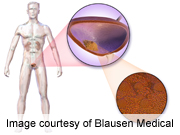
WEDNESDAY, April 18 (HealthDay News) — The addition of two well-tolerated chemotherapy drugs to radiation therapy led to significantly longer survival rates among patients with muscle-invasive bladder cancer.
In a new study splitting 360 patients into groups receiving radiation alone or radiation plus chemotherapy, British researchers found that those undergoing combined therapies had a 67 percent rate of local disease-free survival after two years, compared with 54 percent in the radiation group. Five-year overall survival rates were 48 percent in the chemo-radiation group, compared with 35 percent in the radiation-only group.
“Overall, the results establish that the addition of chemotherapy to radiotherapy should become standard practice for organ-preserving treatments of bladder cancer,” said Dr. Manish Vira, director of the fellowship program in urologic oncology at the Arthur Smith Institute for Urology in Lake Success, N.Y. “The tried-and-true treatment method is still [bladder removal] and certainly we are moving toward a more multi-disciplinary approach.”
The study is published April 19 in the New England Journal of Medicine.
About 385,000 cases of bladder cancer are diagnosed annually worldwide, according to study authors, with the average age at diagnosis over 70. For those whose cancer has invaded the bladder muscle, five-year survival rates are about 45 percent regardless of treatment.
For younger, healthier patients, bladder removal — known as radical cystectomy — is considered the gold standard of care for invasive bladder cancer. But older patients with co-existing medical conditions may not be as well-equipped to tolerate complications of the procedure, experts said.
The new study, the largest late-stage trial of its kind, was conducted at 45 medical facilities in the United Kingdom. Patients were randomly assigned to undergo daily radiation alone or radiation along with two chemotherapy drugs, fluorouracil and mitomycin C. In addition to improved survival rates, the number of patients needing bladder removal as a “salvage therapy” — because other treatments failed — was lower among those receiving radiation plus chemotherapy.
Adverse effects from the chemotherapy — including diarrhea, sore mouth or suppression of blood cell production — were low among participants and were managed by lowering drug dosages, said study author Dr. Nicholas James, a professor of clinical oncology at the University of Birmingham. in England.
Cost of the chemotherapy drugs is relatively inexpensive, he said — about $1,600, plus pharmacy and intravenous administration costs.
“We were pleasantly surprised by the overall results, particularly the low reported toxicity in the chemo-radiotherapy arm compared to the radiotherapy-only group,” James said. “We feel the results are sufficient to change practice . . . the drugs are cheap and safety was good in an elderly population.”
More information
The U.S. National Library of Medicine has more about bladder cancer.

